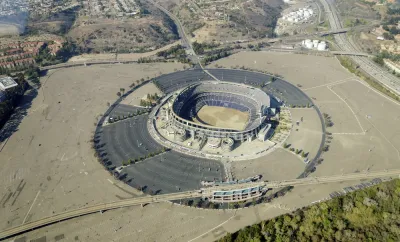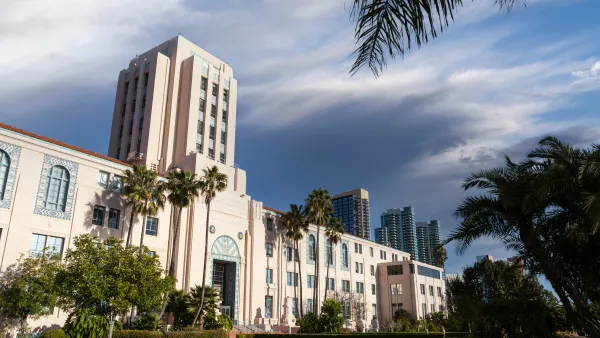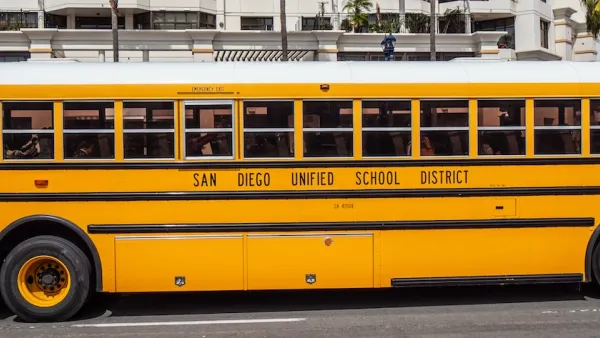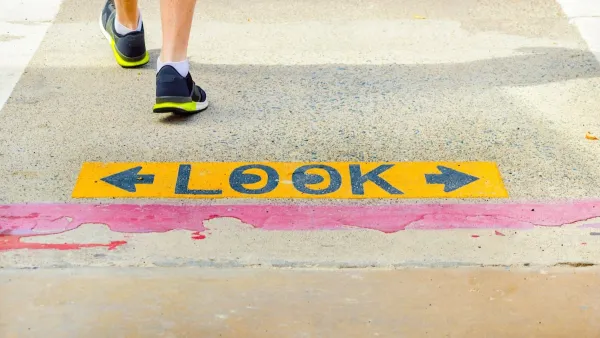For San Diego's Mission Valley Qualcomm Stadium site, AIA-SD and E+DC urge a structured and orderly planning and disposition process.

San Diego is experiencing "déjà vu all over again" (to quote Yogi Berra). Only a short while after saying no to the Charger's ultimatum of $2 billion or LA-exit, a new "investor group" has come up with a development proposal for the 166 acres of city owned land, which is occupied by the Chargers former home, Qualcomm Stadium. The proposal is named "Soccer City." This time it's a professional soccer fueled proposal making a grab for public assets—although at least this time it is allegedly for fair market value (after various asserted offsets). Under the proposal, Qualcomm stadium will be torn down and replaced with a new smaller stadium and surrounded with mixed-use development and open space. The investor group is pushing a sense of urgency in order to land a Major League Soccer franchise. An MLS committee is currently reviewing proposals from 12 cities for 4 expansion teams. Having stadium financing in place is a prerequisite for selection. The Soccer City proposal, with the usual allotment of tantalizing renderings, promises a 25 acre "sports and entertainment" district, including a 30,000 seat stadium billed as the "steepest in America," and "55 acres of green space," including a river park (yes, San Diego has a "river"), 5,000 residential units, and two hotels. The stadium is proposed to host both a new MLS team and San Diego State University's Aztecs football team, although the University has yet to sign on as a supporter and has voiced concerns about the stadium's capacity.
The San Diego chapter of the American Institute of Architects (AIASD) and the Environment + Design Council (E+DC) have written an open letter to the city's Mayor and City Council. The AIASD and E+DC are less concerned with the content of the proposal than the process to get there. The letter urges a thoughtful, open, and competitive process, stating:
[T]he AIASD and the E+DC urge the Mayor and City Council to follow a structured and orderly planning and disposition process, and to remember that, when the public is not involved in such a process up front and in a way that builds trust and confidence, the public and their attorneys will most assuredly protest and cause untimely years in court, be subject to referendums, and generally cause controversy and chaos. Following a structured process assures the public interest is best served, the City is better assured of doing the right thing for the land and our citizens, and it also reduces the potential for legal challenges by critics of whatever action the City takes. Our organizations believe that the public interest is best served by a competitive selection process using a Request for Qualifications (RFQ) or Request for Proposal (RFP) that allows for weighted criteria to evaluate developer qualifications and alternative proposals. The Qualcomm site is an extremely valuable regional asset, both economically and socially, and its redevelopment should be based upon a clear understanding and articulation of both community and regional benefits.
Before even getting to a RFQ and RFP though, the groups recommend:
[T]hat a citizen advisory commission be promptly appointed to develop a strong civic vision for the site, establish a framework plan based on that vision, identify selection criteria for the RFQ/RFP, assist the City in managing the selection process, and guide the implementation of the selected development proposal.
Renderings of the Soccer City proposal can be found on the developer's website "gallery." For the full letter, see it at the source article.
FULL STORY: AIA-SD and E+DC open letter regarding the Soccer City proposal for the Qualcomm Stadium site

National Parks Layoffs Will Cause Communities to Lose Billions
Thousands of essential park workers were laid off this week, just before the busy spring break season.

Retro-silient?: America’s First “Eco-burb,” The Woodlands Turns 50
A master-planned community north of Houston offers lessons on green infrastructure and resilient design, but falls short of its founder’s lofty affordability and walkability goals.

Delivering for America Plan Will Downgrade Mail Service in at Least 49.5 Percent of Zip Codes
Republican and Democrat lawmakers criticize the plan for its disproportionate negative impact on rural communities.

Test News Post 1
This is a summary

Test News Headline 46
Test for the image on the front page.

Balancing Bombs and Butterflies: How the National Guard Protects a Rare Species
The National Guard at Fort Indiantown Gap uses GIS technology and land management strategies to balance military training with conservation efforts, ensuring the survival of the rare eastern regal fritillary butterfly.
Urban Design for Planners 1: Software Tools
This six-course series explores essential urban design concepts using open source software and equips planners with the tools they need to participate fully in the urban design process.
Planning for Universal Design
Learn the tools for implementing Universal Design in planning regulations.
EMC Planning Group, Inc.
Planetizen
Planetizen
Mpact (formerly Rail~Volution)
Great Falls Development Authority, Inc.
HUDs Office of Policy Development and Research
NYU Wagner Graduate School of Public Service





























